Vintage Treasures: A Door Into Ocean by Joan Slonczewski
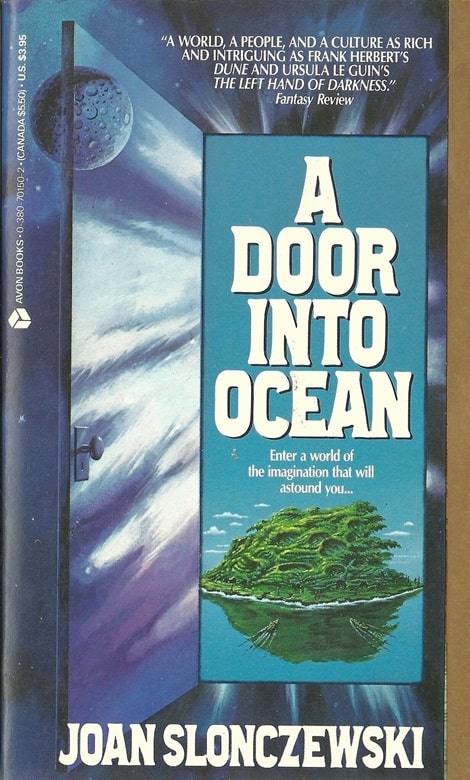 |
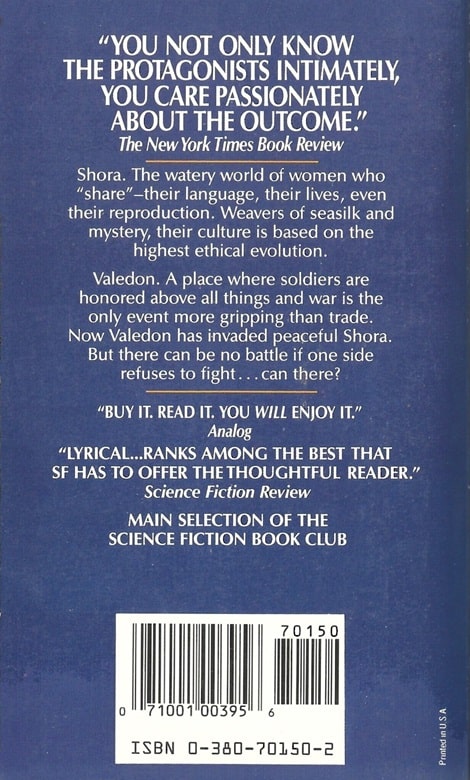 |
A Door Into Ocean (Avon, February 1987). Cover by Line
Joan Slonczewski’s first novel, Still Forms on Foxfield, was published in 1980, but it was their second novel, A Door Into Ocean, which made a real splash, winning the John W. Campbell Memorial Award for Best Science Fiction Novel (not to be confused with the old Campbell Award for Best New Writer, now called the Astounding Award, on account of Campbell being a racist goofball.)
Slonczewski is referred to as ‘she’ and ‘her’ on virtually every bio and interview I’ve found on the web — including the Kenyon College faculty page where Slonczewski is a Chair of Biology — but their website and Wikipedia page give their pronouns as they, them, theirs, so that’s what I’ll use here.
A Door Into Ocean was the book that made readers sit up and take notice of Slonczewski. They followed it with three more books in what became known as the Elysium Cycle: Daughter of Elysium (1993), The Children Star (1998), and Brain Plague (2000). Often compared to Le Guin’s The Left Hand of Darkness, A Door into Ocean explores a colony planet covered entirely by water, occupied by an all-female offshoot of humanity who have become skilled genetic engineers.
[Click the images for a door to bigger versions.]
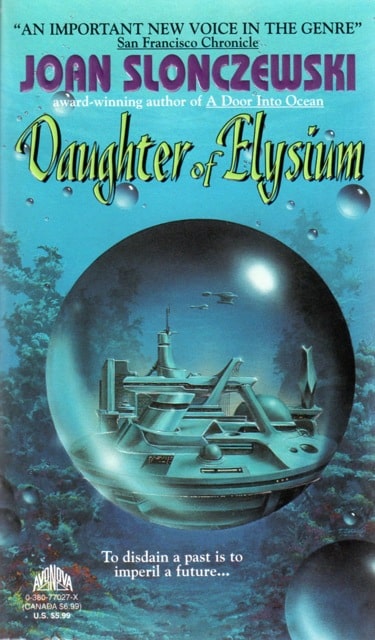 |
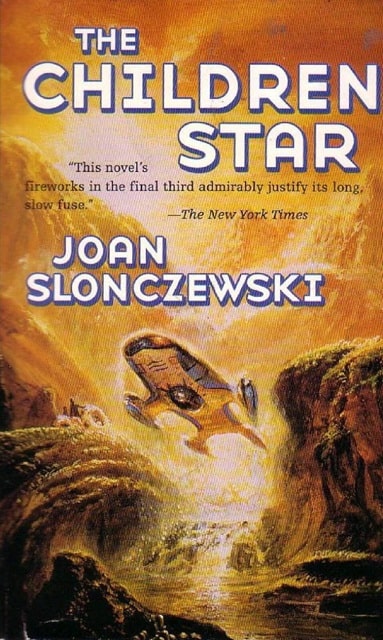 |
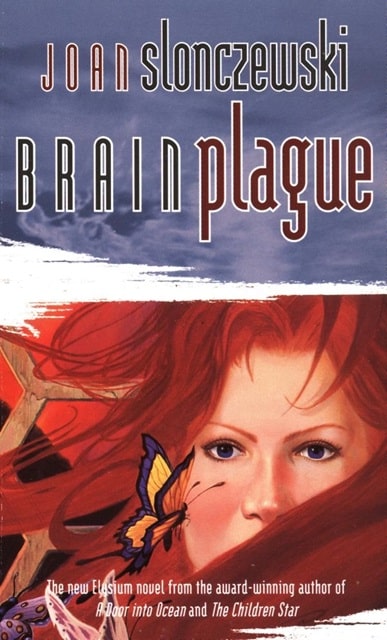 |
Other novels in the Elysium Cycle: Daughter of Elysium (AvoNova, December 1994), The Children Star
(Tor, April 1999), and Brain Plague (Tor, March 2001). Covers: Tim Jacobus, Bob Eggleton, Alan Pollack
Jo Walton does a fine job explaining the set-up at Tor.com.
A Door Into Ocean is set a long time in the future. There was a galactic empire that collapsed in war a thousand years ago, and there used to be a thousand inhabited planets, many of them terraformed. Now there are 93 inhabited planets, and there’s slow FTL connecting them. Atomic manipulation and genetic engineering are both forbidden. Because FTL is slow, control over the planets is tenuous, an Envoy from the Patriarch visits every nine years to make sure all is going according to plan. Valedon and Shora are both inhabited and both in the same system — Shora is Valedon’s “Ocean Moon,” it has no land, and the inhabitants live on rafts. Valedon has been part of the Patriarchal system all the time, Shora has spent a thousand years ignored, with a constant population of less than a million living at a very low tech level. In the last generation Valedon has come into contact with Shora again, and their different ways of living bring them into conflict. The inhabitants of Shora call themselves “Sharers” and chose names that commemorate their worst flaws they need to live down. The inhabitants of Valan live in castes, have armies, and don’t share anything.
What I remembered best about this book was the way the Sharers live in on floating rafts as part of a huge complex network of genetically engineered communication devices, and how their reaction to anything new is to learn about it, and the worst punishment they know is “Unspeaking”: cutting off communication. Their way of life is very unusual and memorable — and their tactics for dealing with the invasion of Valan traders and then soldiers would have been familiar to Gandhi. They have genetically engineered themselves to be all female, to have purple skins for better oxygen retention under water. They have genetically engineered everything around them to suit their way of life. They look to the Valans and the Patriarch’s Envoy as if they have no technology, while in fact their technology predates and outstrips everything. They worry about seeing themselves clearly and naming themselves and sharing responsibility for their children and their planet.
This is the story of how Shora defeats Valedon and the Patriarchy, despite the other side appearing to have all the advantage. It’s also the story of how Spinnel, a poor boy from Valedon, grows up and comes to know himself.
James Schellenberg has an excellent review at the Canadian magazine Challenging Destiny.
A Door Into Ocean is an extraordinary novel, an astonishing explosion of ideas, themes, and speculation… A Door Into Ocean handles complex issues such as sexuality, linguistic barriers, and environmentalism with aplomb, and deftly makes thought-provoking points inside the context of the story…
Shora is an ocean moon, in orbit around the planet of Valedon. The Valan society is easy to imagine. Think of Earth, perhaps with patriarchal values even more firmly entrenched, just as militaristic, and a few advances in space flight. Valedon, however, is under the thumb of the Patriarch, the ruler of a hundred scattered planets. The Patriarch’s Envoy arrives at Valedon every ten years, and has control of the forbidden technology of atom smashing. On the visit that is depicted in the book, the Envoy commands Valedon to take control of Shora. Learning about Shoran society, and how it resists invasion, makes up the major portion of the book, and this is where Slonczewski’s plot relocates in absolutely unique territory..
The book opens with Merwen the Impatient and Usha the Inconsiderate, two Shorans, arriving in a small town on Valedon. We get Merwen’s sense of culture shock — cross-cultural experiences being one of the most basic themes in the book — as well as planet shock, to coin a phrase. In the opening paragraph, Merwen tries to control her reaction to the sight of land: “Across the sky, where Merwen was born, none but the dead ever sank to touch the world’s floor…”
Merwen carries an enormous burden, knowing how much Shora depends on her, but she is also dealing with her impetuous daughter, Lystra. Lystra fumes about Valan influence on Shora but falls in love with Spinel. Lady Berenice is engaged to Realgar, the army officer in charge of invading her adopted planet, Shora. Spinel is perhaps our entry character into all this complexity and ethical puzzling — he is a young boy, becoming a man, and he joins up with Merwen and Usha out of a desperate wish to get out of his stifling home town…
A Door Into Ocean is a page-turner, highly readable, and we fall into the trap of expecting a blowout of an ending. The subtle, intelligent essence of the climax could be predicted by careful readers (or those, like me, who are re-reading the book and watching for clues), but it still comes as quite a shock. Another layer of irony.
Read the complete review here.
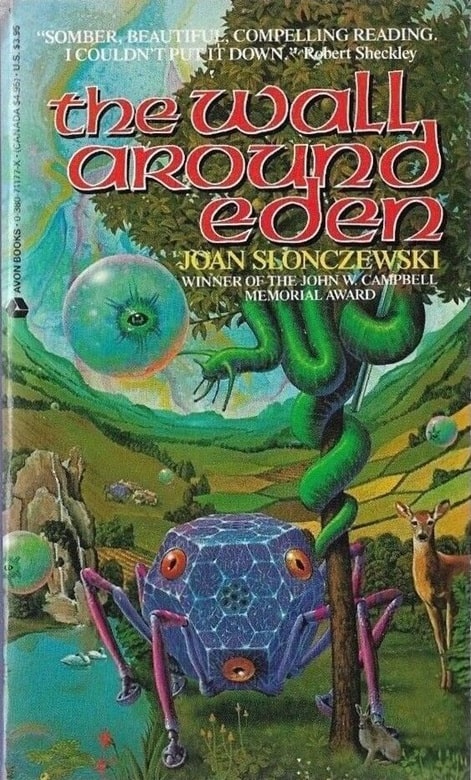 |
 |
Other books by Joan Slonczewski: The Wall Around Eden (Avon, December 1990) and
The Highest Frontier (Tor, September 2012). Covers by Nicholas Jainschigg, unknown
The complete Elysium Cycle consists of:
A Door Into Ocean (Arbor House, 403 pages, $17.95 in hardcover, February 1986) — cover by Ron Walotsky
Daughter of Elysium (AvoNova, 521 pages, $25 in hardcover, August 1993) — cover by Tim Jacobus
The Children Star (Tor, 349 pages, $24.95 in hardcover, September 1998) — cover by Bob Eggleton
Brain Plague (Tor, 384 pages, $24.95 in hardcover, August 2000) — cover by Alan Pollack
Joan Slonczewski’s most recent novel is The Highest Frontier (Tor, 2011), and they seem to have devoted their recent energy to their textbook, Microbiology: An Evolving Science (W. W. Norton), written with John W. Foster and Erik Zinser and now in its fifth edition, and their excellent blog Ultraphyte, which is packed with interesting stuff about tardigrades, biology, artificial intelligence, bioprinted hearts, and much more.
See all our recent Vintage Treasures here.
I suspect that the bios and especially the interviews just haven’t been updated with more recent pronoun information. We all know how rarely some places update their websites, or completely forget about some parts of it, and it would seem that interview updates are probably even rarer.
If memory serves, it was John Scalzi recently on Bluesky who was noting how frequently he sees his own out-of-date bios.
Allen,
You’re probably right. It’s a lot to expect to update old interviews. Though I was surprised about the faculty page. But it’s not for me to question where someone wants to update their pronoun details. People’s professional identity is often separate from their publishing persona.